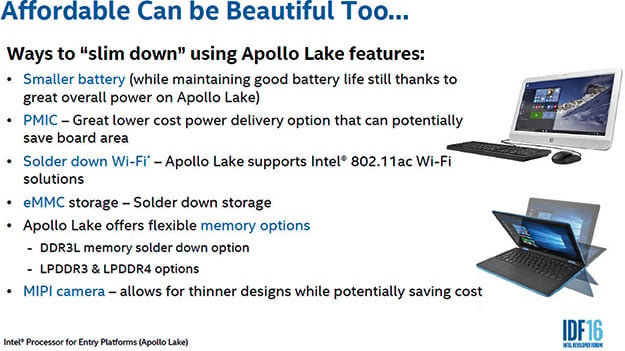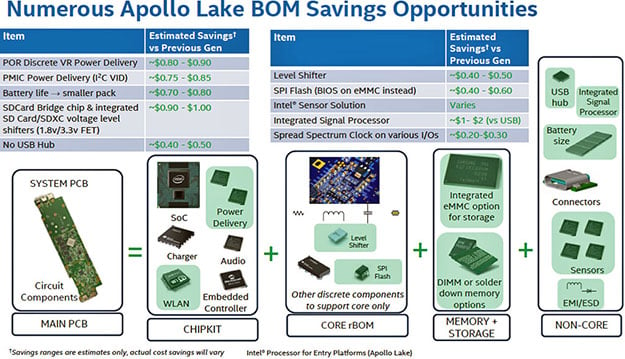Intel Apollo Lake Platform With 14nm Goldmont Atom Cores Unveiled, Enter The Cloudbook
While it’s definitely fun to talk about enthusiast parts like Intel’s upcoming deca-core Extreme Edition processors, we have to keep in mind that many consumers don’t set their sights that high when it comes to performance and have more meager budgets to navigate. With that in mind, Intel has announced its new Apollo Lake platform, which is targeting the low-end of of the PC and tablet market.
The Apollo Lake platform brings with it a number of enhancements compared to its Braswell and Cherry Trail predecessors including a new Atom microarchitecture: Goldmont. Like the Airmont architecture that came before it, Goldmont is built on a 14nm manufacturing process and supports up to four cores. However, Goldmont has at least one trick up its sleeve with the inclusion of Intel’s Gen9 graphics architecture introduced with Skylake.
Intel is hoping that OEMs will embrace Apollo Lake for its Cloudbook initiative, which covers notebooks ranging in price from $169 to $269. Cloudbooks go toe-to-toe with Google’s Chromebooks, of course come preloaded with Windows 10 and come in clamshell configuration with screen sizes ranging from 11.6 inches to 14 inches. Cloudbooks also include devices in a 11.6-inch convertible form-factor. These machines all have onboard solid state storage onboard ranging in size from 2GB to 32GB in its current iteration.
For 2016 Cloudbooks, Intel has issued a reference design including an Apollo Lake SoC, an 11.6-inch 1080p display, 4GB of LPDDR3 1866 memory, 64GB M.2 SATA3 SSD, 802.11ac Wi-Fi and Bluetooth 4.1. Although Intel hasn’t revealed any detailed specifications for Apollo Lake processors, the standard company line is that these chips will improve performance, reduce power consumption and increase the battery life of systems compared to what’s possible with current generation systems.
In addition to the reference design, Intel also gives a breakdown of build of materials (BOM) cost savings that can be accomplished by the further integration of components in the Apollo Lake SoC. Intel also has a list of recommended components that OEMs can select from to combine for saving of between $5.55 to $7.35 per machine. In today’s cutthroat PC market which seems to be making a mad dash to the bottom when it comes to pricing while at the same time fighting dwindling sales, what seems like a few bucks to us means a whole lot to OEMs that are shipping millions of units a quarter.
While we haven’t been giving much to go on when it comes to tangible specs on Apollo Lake (like clock speeds and core counts), rest assured that we’ll be seeing design announcements and a lot more details at Computex in a few months.



